The Best Bodybuilding Workouts for Each Body Part
Simple bodybuilding programs are a little too easy to find. You could pull them from fitness magazines — those ghost-written workouts that your favorite bodybuilders supposedly follow. You could roll the dice and ask an artificial intelligence chatbot to generate one for you. Or, you could attempt to develop one for yourself.
Just a few problems there. The high intensity, high volume programs used by the pros do not tend to be sustainable for the rest of us due to some physiological (and often pharmaceutical) reasons. Most people also aren’t ready to trust their potential gains to an algorithm-fueled robot, so that leaves you creating a program for yourself.
Consider a time-tested axiom before diving in: It’s not hard to create a good bodybuilding workout program, but it’s also not hard to create a bad one. Fortunately, we’ve got your back. And your chest, shoulders, arms, and legs.
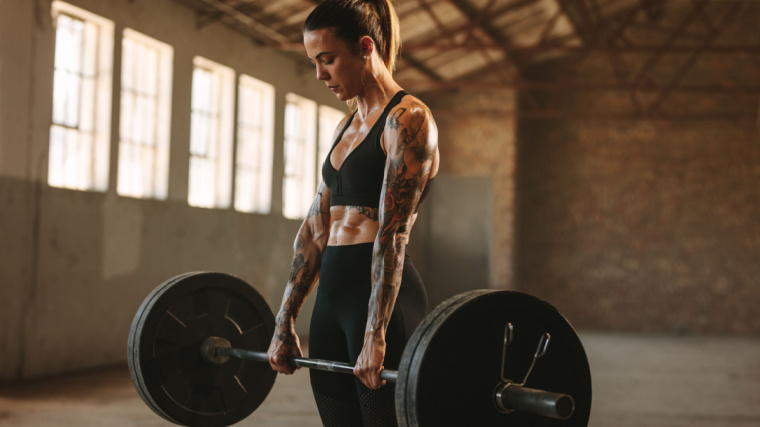
Here you will find evidence-based workouts to build every major area of an aesthetic physique. These workouts assume you’re a relatively healthy lifter with at least some experience in the gym (i.e. not a true beginner who could benefit from a more generalized approach). These plans work best with a body part split across the week.
Bookmark these workouts for your next hypertrophy training block and support the workouts with enough food to fuel performance, recovery, and growth so you can get started adding size.
Best Bodybuilding Workouts for Each Body Part
Best Bodybuilding Workout for Chest
The chest muscles play a prominent role in our physique. They are most often trained by multi-joint, upper body pushing exercises. The angle the “push” can be used to bias certain portions of the chest, allowing us to fully develop this region. In addition to pushing exercises, single joint exercises can also be used to target the chest. Single-joint exercise serves as “icing on the cake,” providing a touch of additional training stimulus.
The Complete Chest Workout
Just about any repetition range can build muscle. (1)(2) This engaging workout begins with the heaviest exercise. As the workout progresses, moderate repetition, moderate weight exercises are introduced as compound sets — a time-efficient superset technique that pairs movements targeting the same muscles back-to-back without rest. The workout ends with high repetition “pump work,” leaning into the metabolic mechanisms of muscle hypertrophy. (3) This general format is repeated for workouts for all body parts.
This chest workout is designed to be performed once per week. Select weights that allow completion of repetitions is near the lower end of the repetition range. Sets need not be taken to failure but should flirt with it. Meaning, sets must reach a high level of effort. (4)(5) When you end the set, you should feel like you have three or fewer repetitions remaining “in the tank.”
When you’re able to complete sets at the top end of the repetition range, add five to 10 pounds. This progression method “resets” your sets back toward the lower bound of the repetition range, allowing your to progress repetition volume once again in subsequent weeks.
Barbell Bench Press
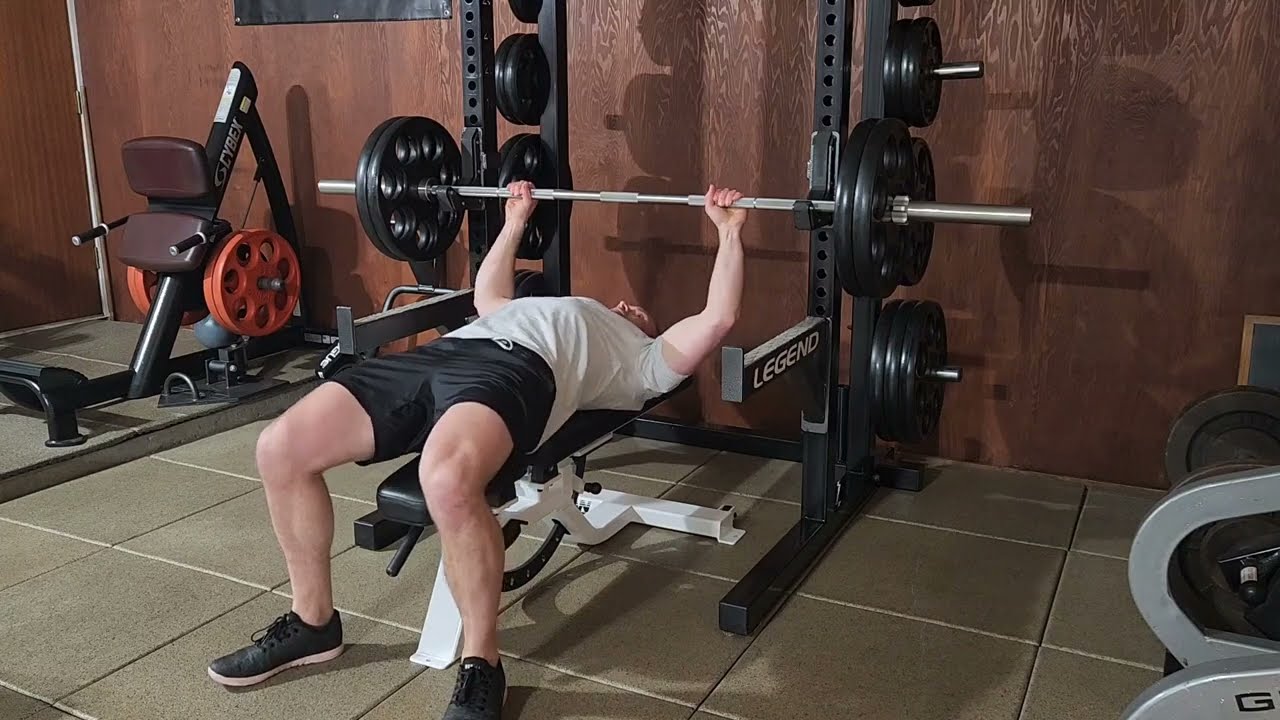
- How to Do it: Lie on a bench with your back arched and shoulder blades pulled down and together (“in your back pockets”). Unrack the bar and lower it to your chest. Press the bar upward until your elbows are straight but not locked.
- Sets and Reps: 3 x 6-8
- Rest time: Rest three minutes seconds between sets.
Dip
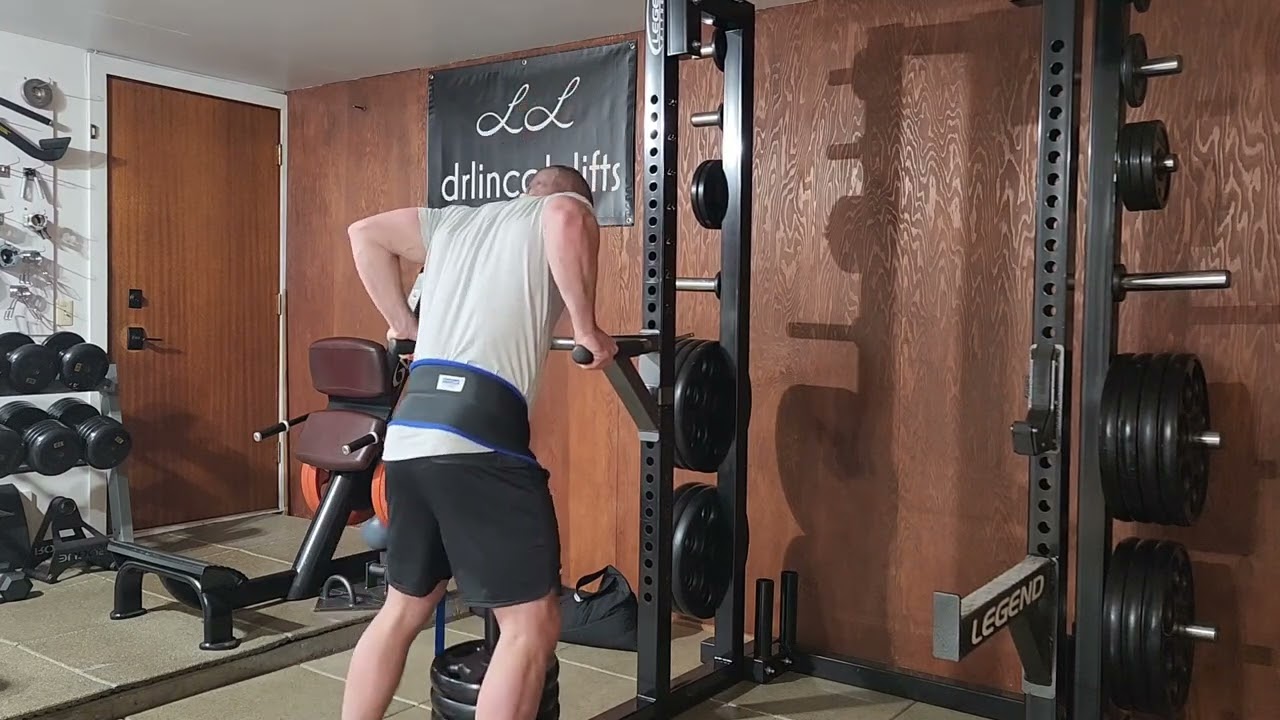
- How to Do it: Support your body from a dip bar and lean slightly forward. Lower yourself until you feel a stretch across the front of your chest and shoulders or until your upper arms break parallel. Add weight or assistance as needed to achieve the target repetition range.
- Sets and Reps: 3 x 8-12
- Rest time: Move immediately to the next exercise without rest.
Incline Dumbbell Flye Press
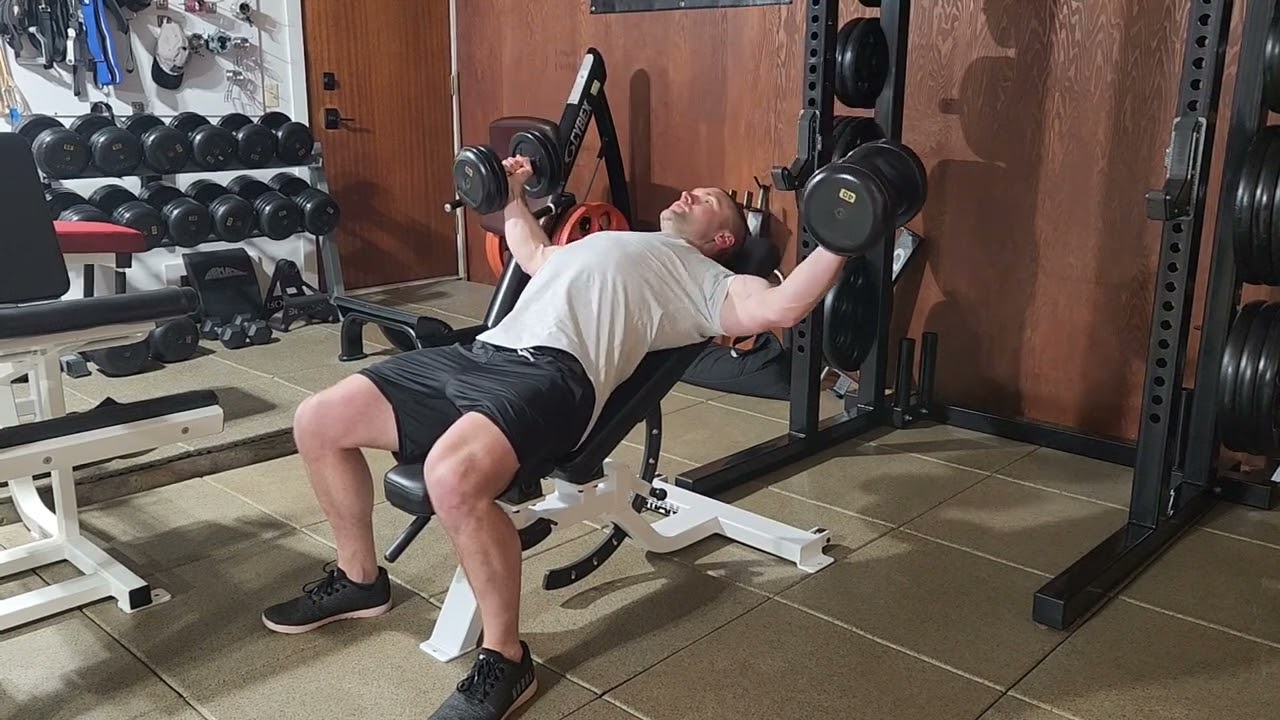
- How to Do it: Lie on a 30- to-45-degree incline bench and begin with the dumbbells pressed locked out above your chest. Face your palms together and lower the weights in a flye, keeping a slight bend in your arms. From the bottom position, pull the weights in toward your shoulders and press the weights up to lockout.
- Sets and Reps: 3 x 12-16
- Rest time: Rest two minutes before repeating the previous exercise.
Machine Incline Press
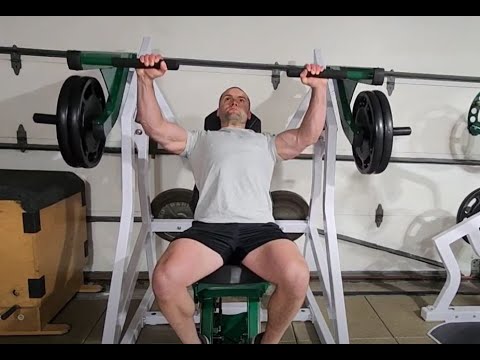
- How to Do it: Sit with your back and buttocks supported on an incline press machine. Push the handles along the arc of the machine’s path until your elbows are straight but not locked. Control back to the start position.
- Sets and Reps: 2 x 16-20
- Rest time: Rest 90 seconds between sets.
Muscles Trained on Chest Day
Chest day often draws added attention because the pecs are featured so prominently when you check the mirror, even more so once you get an awesome pump going mid-session. The majority of chest movements will also recruit “the pressing muscles” — your shoulders and triceps — for assistance.
Pectorals
When viewed from the front, the upper bodies of modern bodybuilders are dominated by well-developed chest muscles. The pectoralis major is the largest and most superficial chest muscle. All parts of the pectoralis major act to draw the arms toward the body, pull the arms together in front of the body, and internally rotate the arms. The upper portion of the pectoralis major also raises the arm. Therefore, a wide variety of exercises target the pecs.
Anterior Deltoids
The anterior deltoids, or “front delts,” share the same actions as the pectoralis major. Conveniently, this means that anterior deltoids are trained during chest workouts, such as the one above, and during direct shoulder workouts.
Triceps
The triceps brachii primarily serve to extend your elbows (straighten your arms). Because of this, compound movements such as pressing and dips can be counted toward total triceps training volume. This aesthetic “three-headed” muscle fills t-shirt sleeves more readily than any other arm muscle.
How to Warm-Up Your Chest
A traditional warm-up has two components: 1) the “general warm-up” and 2) the “specific warm-up.” The general warm-up elevates body temperature, improves oxygen delivery to muscle and other body tissues, and improves joint freedom of motion. It typically consists of short duration, low-to-moderate intensity cardiovascular exercise (e.g. air bike, rowing, jogging, or jumping rope).
The specific warm-up primes areas of the body and movement patterns to be used in the subsequent workout for improved technique and performance. It is also a good time for dedicated mobility exercises and/or exercises intended to reduce risk of injury.
A specific warm-up for the chest may consist of exercises to prepare the upper body and spine for proper positions during pressing, stimulate muscle contractions of the muscles to be trained, and reinforce shoulder stability. It is wise to include lower intensity sets of the workout’s first exercise at the tail end of the specific warm-up.
Chest Warm-Up
- Cardio: Five minutes, low-to-moderate intensity effort
- Band Pull-Apart: 2 x 15
- Foam Roller Thoracic (Upper Back) Extensions: 2 x 10
- Push-Up: 2 x 10
- Bench Press: 3 x 6–10, work-up sets at light to moderate weight (e.g. approximately 40%, 60%, and 80% of the weight to be used for the first set of the workout’s first exercise).
Best Bodybuilding Workout for Back
A muscular back supports a confident posture, adds width to your upper body, and provides visual interest for those who happen to be walking behind your statuesque physique. That visual interest will come from the various muscles of the back, which converge on the shoulder blades and shoulders.
To create desirable definition and size, training the back from multiple angles using a variety of exercises may be useful. each exercise variation biases certain areas of the back and may result in distinct patterns of muscular development. (6)(7)
Back Width and Thickness Workout
Complete this full back workout once per week. Select weights that allow you to complete repetitions on the lower end of the repetition range. Sets to failure are not necessary to build muscle. (8) However, each set should reach a high level of effort. (4) When you’re able to complete all sets at the top end of the repetition range, add five to 10 pounds.
Three-Point Dumbbell Row
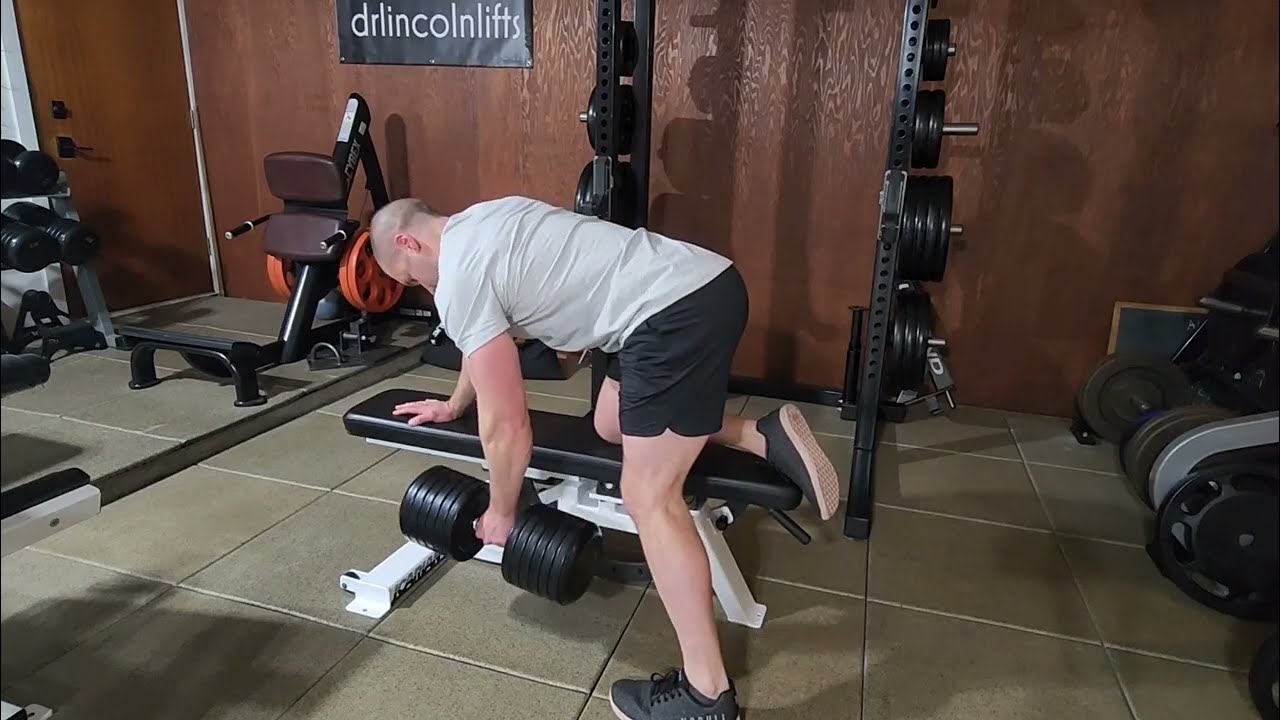
- How to Do it: Perform the three-point dumbbell row with the knee and hand of your non-working side on a flat bench. Initiate the movement by pulling your shoulder blade toward your spine, and row toward the outside of your hip. Lower to a full stretch without rotating or sinking your hips
- Sets and Reps: 3 x 6-8
- Rest time: No rest between sides. Rest three minutes between sets.
Neutral-Grip Lat Pulldown
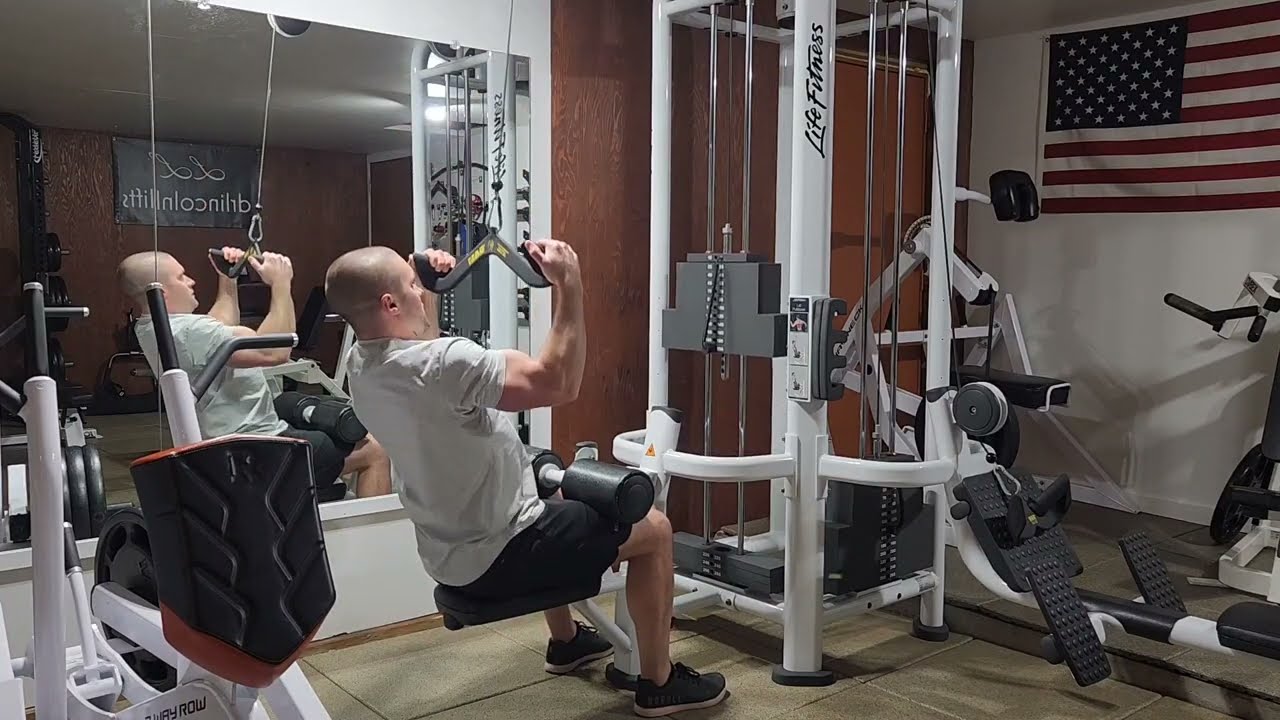
- How to Do it: As the name implies, the neutral-grip lat pulldown is performing using a handles attachment that faces your palms toward each other. Begin in a full overhead position and pull your elbows down to the midline of your ribcage — don’t force the bar to reach your chin or chest.
- Sets and Reps: 3 x 8-12
- Rest time: Rest two and a half minutes between sets.
Machine Wide Row
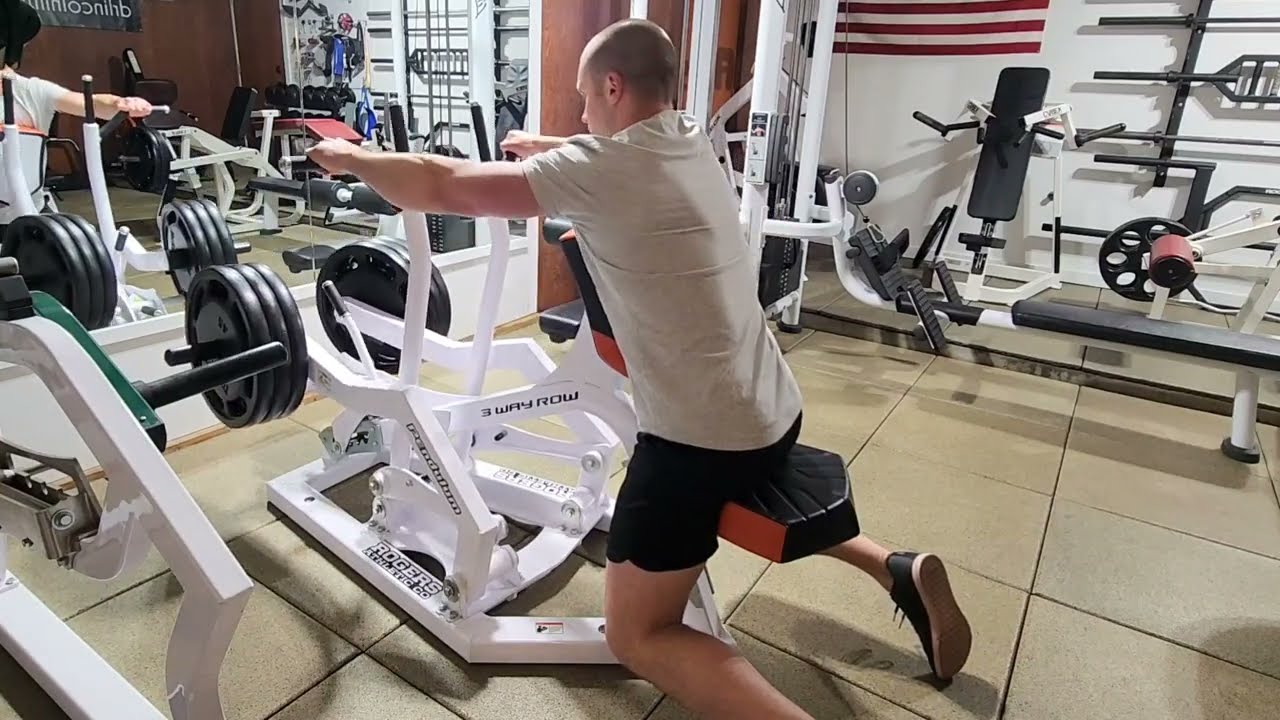
- How to Do it: Set up on a machine with a chest support, grasping the handles with a wide, overhand grip. Initiate movement with your shoulder blades and pull toward your chest. Return to a fully stretched position.
- Sets and Reps: 3 x 12-16
- Rest time: Move immediately to the next exercise without rest.
Cable Flexion Row
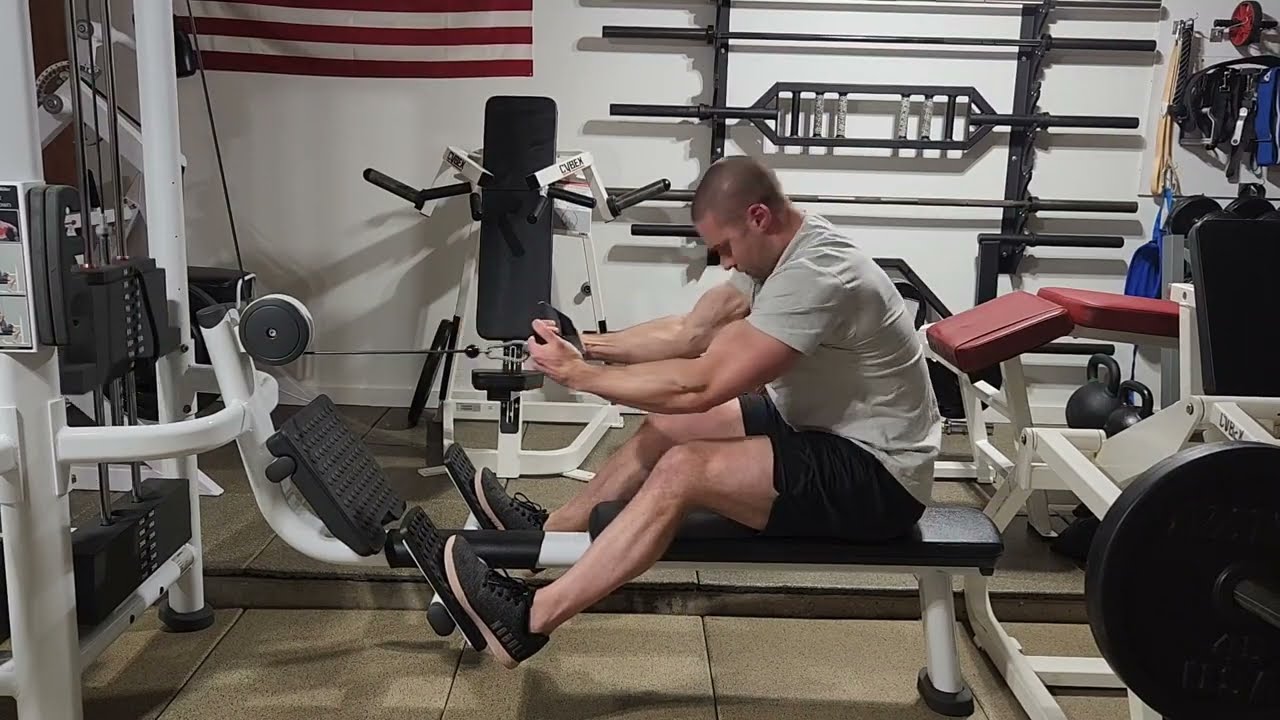
- How to Do it: Perform this seated row variation on a low cable machine. Allow resistance to pull your trunk and shoulder blades toward the machine — your spine should round forward, promoting a massive stretch through your back muscles. Begin by pulling the shoulder blades together and down. As you row the bar toward your torso, extend your spine but do not use momentum from the trunk to drive the movement. Reverse the movement and repeat.
- Sets and Reps: 3 x 16-20
- Rest time: Rest two minutes before repeating the previous exercise.
Muscles Trained on Back Day
Your back is one of the largest muscle groups on your body because a number of various individual muscles coordinate during each movement. This comprehensive workout will address and train a large number of muscles on your posterior torso including the lats, rear shoulders, and upper and mid-back. Your biceps and gripping muscles are also recruited during most exercises.
Mid-Back and Lats
Mid-back muscles, which act on the shoulder blades, create the appearance of a raised, central diamond-shape. Your latissimus dorsi (lats) sweep from the small of the back toward the outsides of your armpits and enhances the appearance of a “V-shaped” torso. These muscles comprise the bulk of the back musculature and are trained by upper-body pulling exercises.
Rear Deltoids
While your rear deltoids are traditionally trained via shoulder-specific exercises (e.g. reverse flyes and cable external rotations), wide and narrow-grip pulling movements also hit the rear deltoids. When considering total weekly training volume for the rear deltoids, it is appropriate to include pulldowns, pullovers, and rows.
Biceps and Other Elbow Flexors
Drawing a resistance toward your body, as performed during pulldowns, trains your elbow flexors. As the most visible elbow flexor, the biceps brachii gets all the glory; however, the brachialis is a deep elbow flexor that boosts the appearance of the biceps by pushing it up — kind of like the supportive parent or friend whom you should probably call and thank (after your workout, of course).
How to Warm-Up Your Back
Once again, it’s a good policy to raise the body’s temperature with some general movement and prime the areas of the body to be trained before jumping into the workout. On top of that, “back day” is a great time to incorporate some direct exercise for the midsection, as many workout splits don’t allocate ab training to one specific day.
Back Warm-Up
- Cardio: Five minutes, low-to-moderate intensity effort
- Abdominal Crunches: 3 x 15-20
- Medicine Ball or Landmine Rotations: 3 x 10-12
- Band Over and Backs: 2 x 10-12
- Three-Point Dumbbell Row: 3 x 6–10, work-up sets at light to moderate weight (e.g. approximately 40%, 60%, and 80% of the weight to be used for the first set of the workout’s first exercise).
Best Bodybuilding Workout for Shoulders
The deltoids are the muscles that envelop your shoulders. Well-developed deltoids appear full and rounded, “capping” the shoulders. The deltoid has three functional parts — anterior, middle, and posterior.
The anterior deltoid is primarily responsible for raising the arms in front of the body (e.g. pressing), pulling the raised arms in toward your midline, and internally rotating the arms. The middle deltoid raises the arms out the sides (e.g. lateral raises and overhead presses) and assists with pulling the raised arms away from your midline (e.g. reverse flye). The posterior deltoid assists with the reverse flye movement in addition to external rotation and driving your arms behind your body (e.g. rows).
While your shoulders clearly get some work on chest day and back day, a dedicated shoulder workout helps to ensure each part receives adequate training. The diverse actions of the deltoids open the door for efficient use of supersets on shoulder day.
The 3D Delt Workout
Perform once per week using weights that allow repetitions at or near the lower boundary of the stated repetition range. Once again, the majority of working sets should be high level of effort with three or fewer repetitions remaining before failure. Machine-based overhead pressing is included to allow lifters to safely approach or achieve failure without a spotter.
Once you reach the top of any repetition range, add five to 10 pounds to the exercise. Be vigilant for stagnating progress or drops in performance, as these features might indicate that it’s time for a deload.
Seated Dumbbell Overhead Press
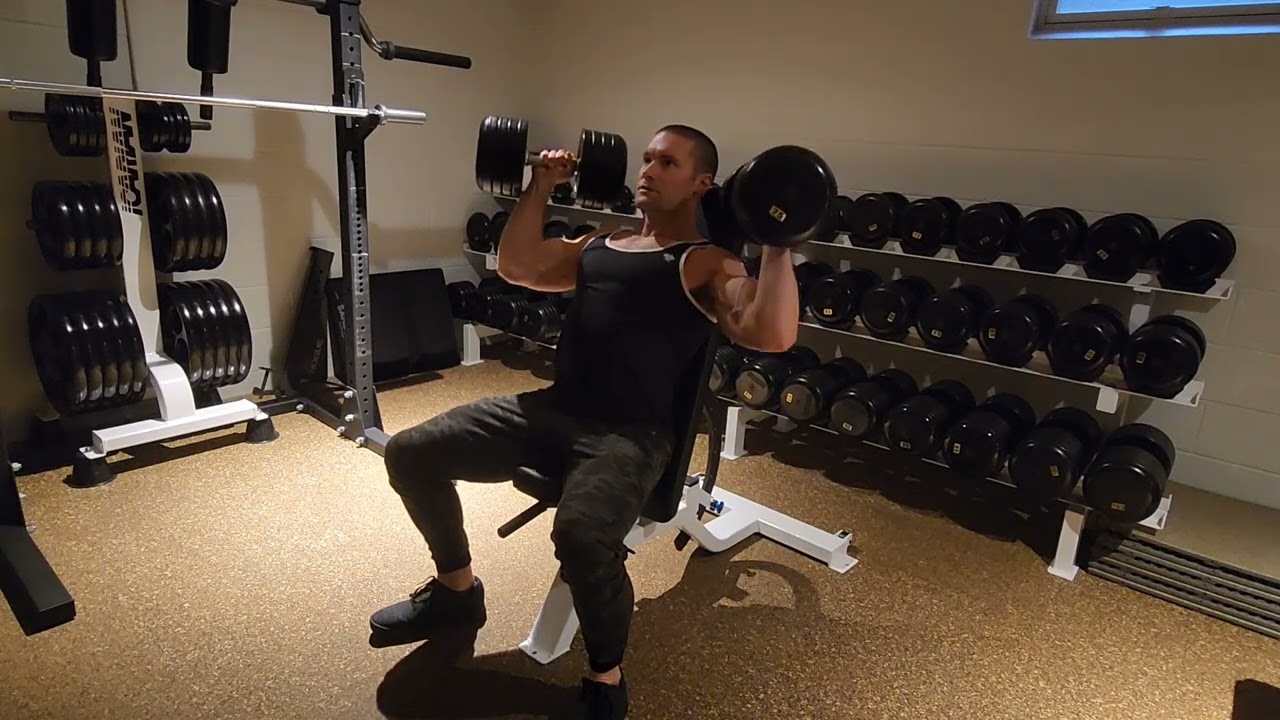
- How to Do it: Sit on a bench with a vertical back support. Rest a dumbbell on each thigh before “kicking” each weight into position at shoulder-level with your palms facing forward or angled slightly in. Press both weights overhead to full lockout before returning to shoulder-level.
- Sets and Reps: 3 x 6-8
- Rest time: Move immediately to the next exercise without rest.
Dumbbell Reverse Flye
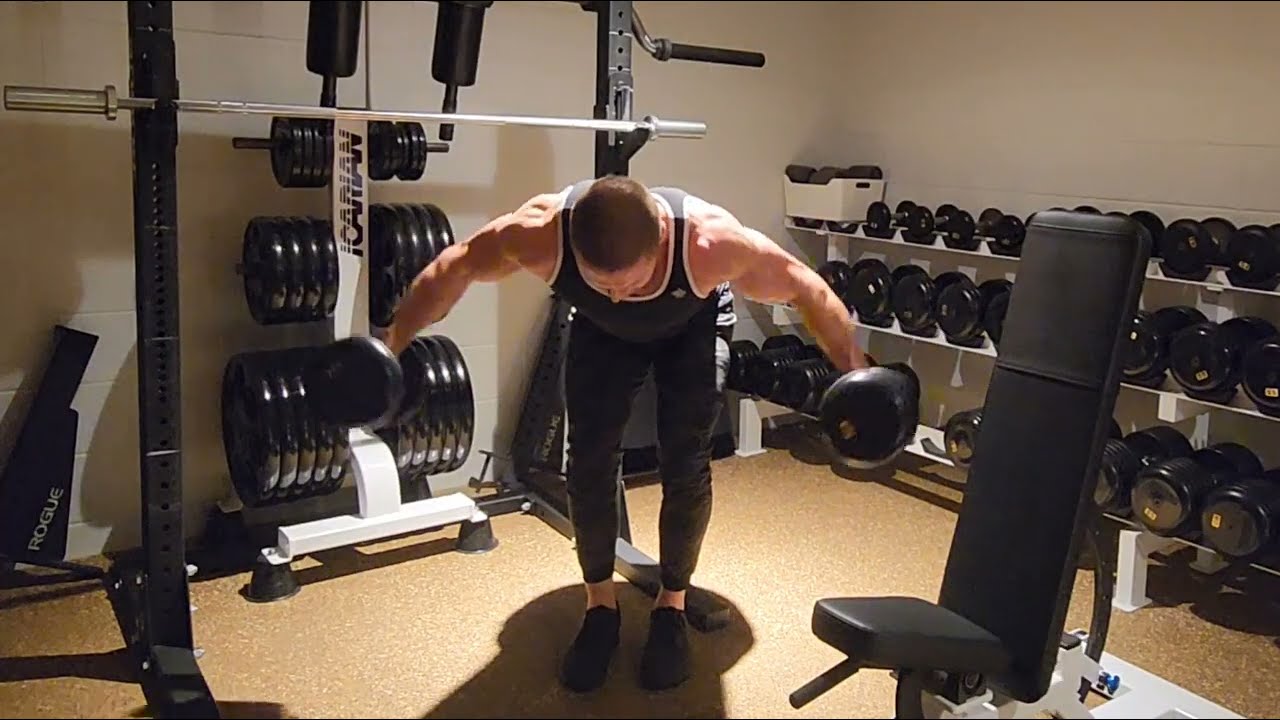
- How to Do it: Stand with a dumbbell in each hand at arm’s length by your sides. Hinge forward at the waist and slightly bend your legs. Slightly bend your elbows and maintain the arm angle throughout the set. Draw your upper arms toward the ceiling, stopping the your elbows are roughly in line with your shoulders. Lower under control — don’t allow the weights to build momentum in the bottom position.
- Sets and Reps: 3 x 12-16
- Rest time: Rest three minutes before repeating the previous exercise.
Machine Shoulder Press
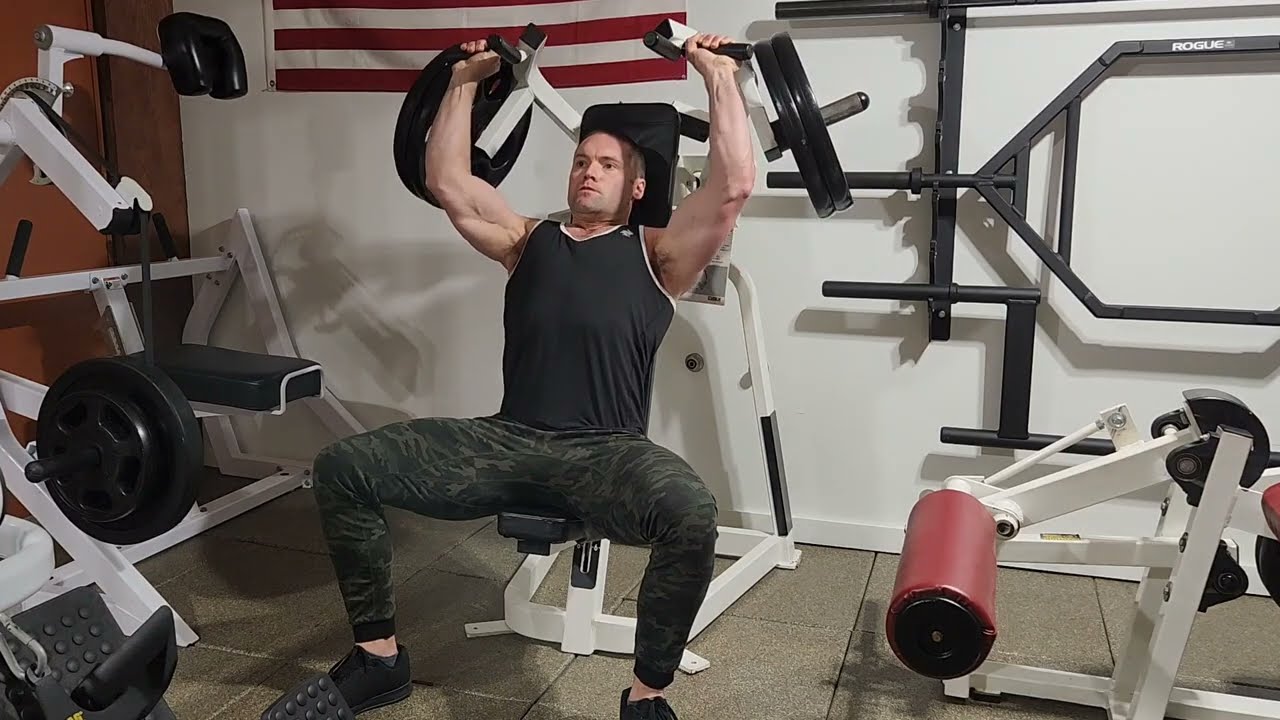
- How to Do it: Sit in an shoulder press machine and adjust the seat height to allow you hands to reach shoulder-height in the bottom position. Take a palms-forward grip and drive the weight up to near-lockout before lowering with control. Aim to move at a steady pace and maintain continuous tension through each repetition.
- Sets and Reps: 3 x 12-16
- Rest time: Rest two minutes between sets.
Face Pull
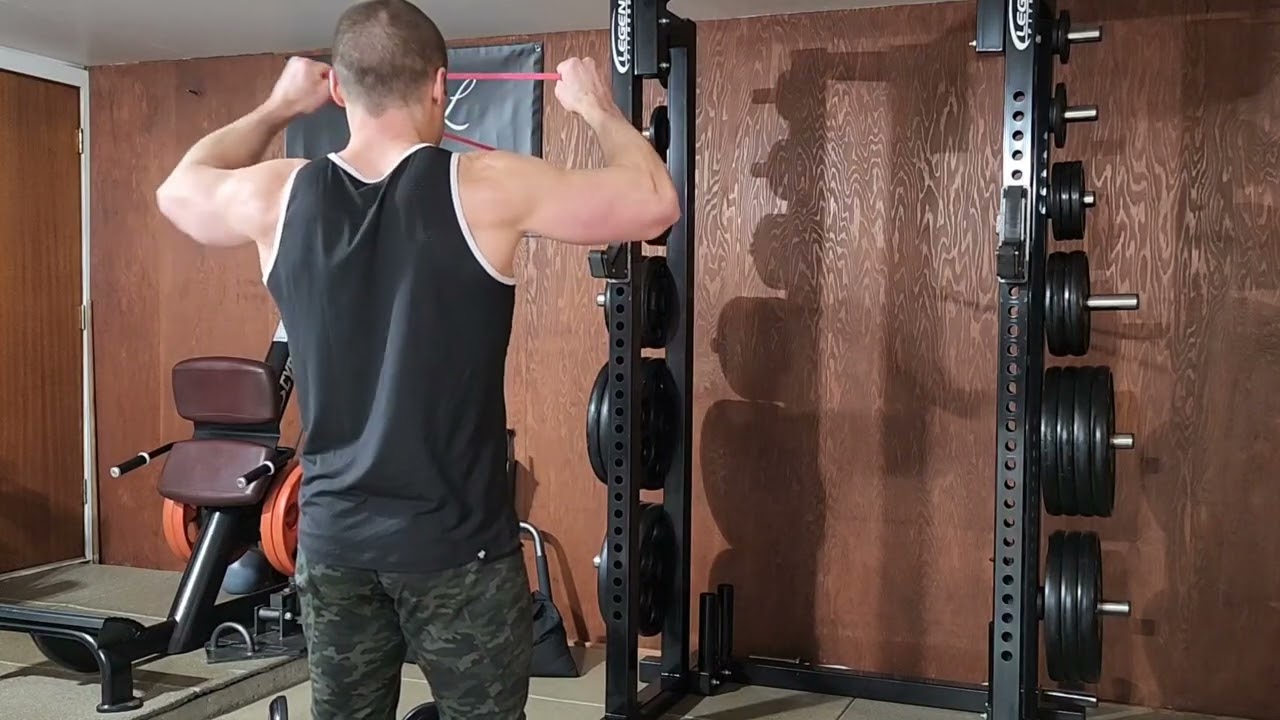
- How to Do it: Set a resistance band or cable pulley at roughly eye-level. Take a palm-down grip and step back to create tension in the stretched position. Begin the face pull by driving your elbows back in line with your shoulders while pulling your hands in line with your eyes or ears. From the contracted position, reach forward until full lockout.
- Sets and Reps: 3 x 12-16
- Rest time: Move immediately to the next exercise without rest.
Lateral Raise
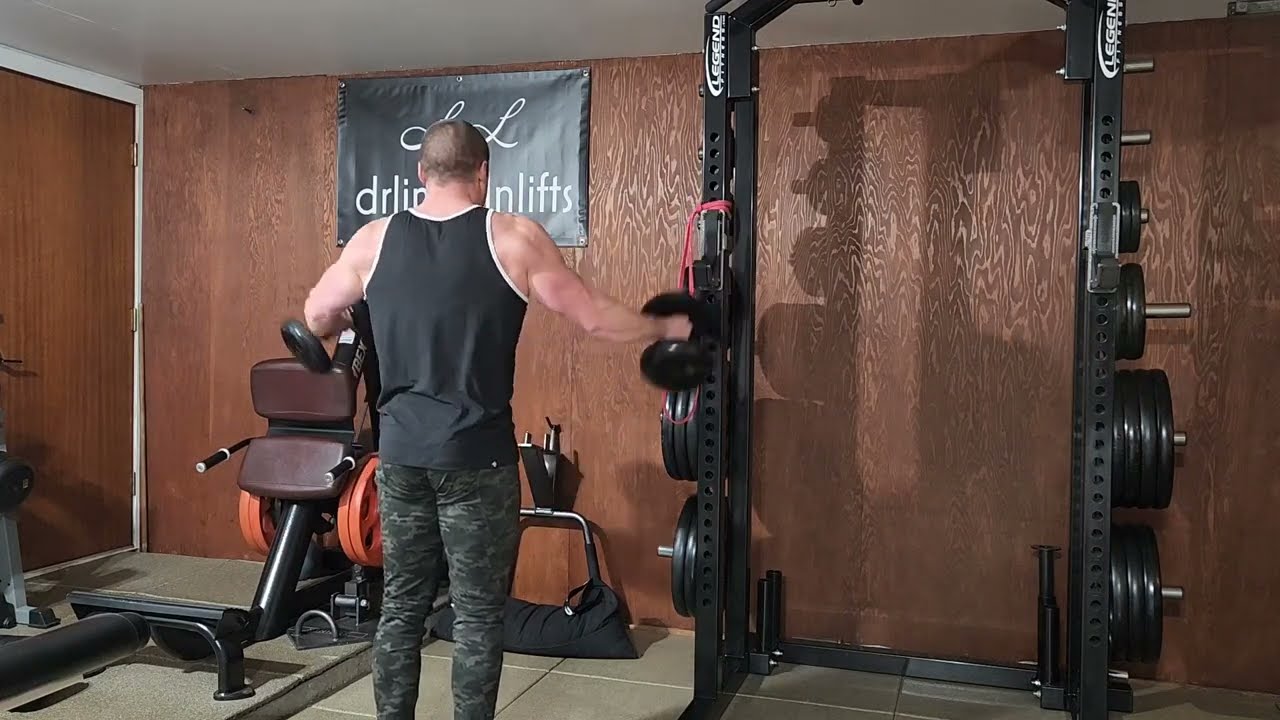
- How to Do it: Stand with a dumbbell in each hand at arm’s length, resting the weights on the front of your thighs. Keep a slight bend in your arms and raise the weights “up and out” until your hands are slightly above shoulder-height. Maintain a tight core and stable torso — don’t allow your hips or back to swing. Lower to the starting position with your hands in front of your thighs.
- Sets and Reps: 3 x 20-24
- Rest time: Rest two minutes before repeating the previous exercise.
Dumbbell Shrug
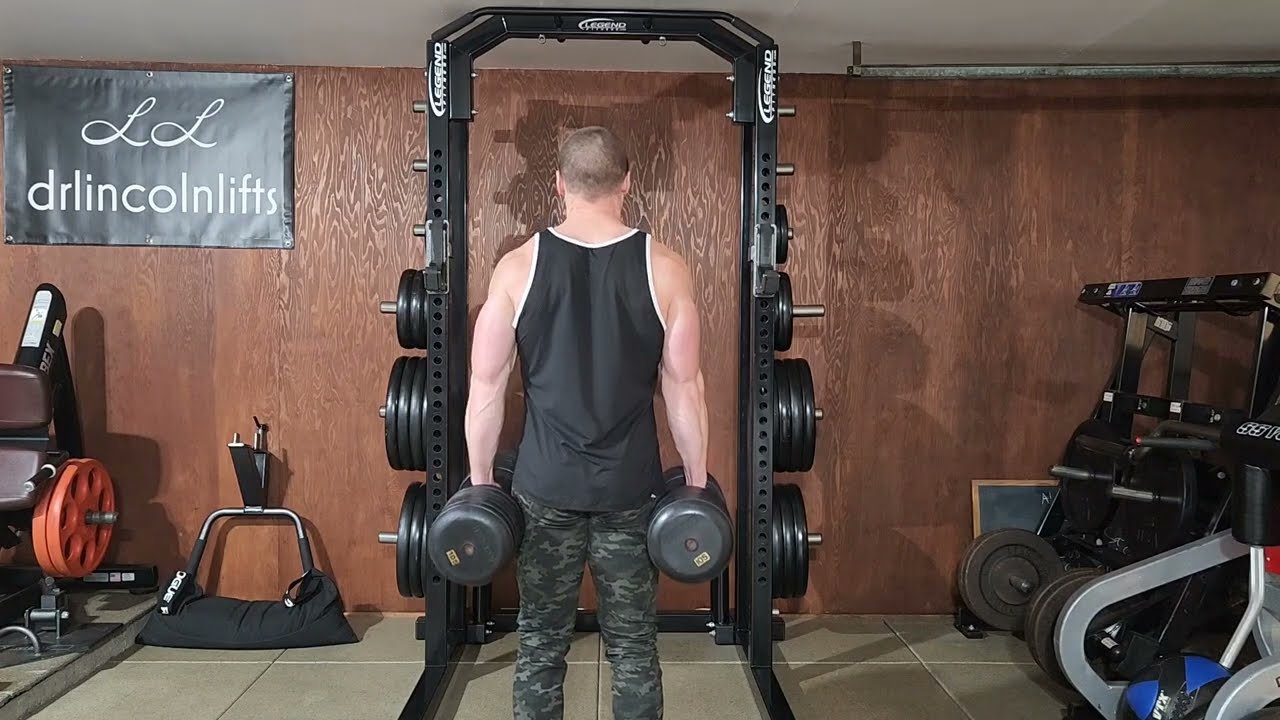
- How to Do it: Stand with a pair of dumbbells at arm’s length by your sides. Drive your shoulders toward the ceiling as high as possible — move vertically without “rolling” your shoulders or pulling your shoulder blades together. Lower to a full stretch.
- Sets and Reps: 2 x 20-24
- Rest time: Rest 90 seconds between sets.
Muscles Trained on Shoulder Day
The shoulder joint is arguably one of the most precarious joints in the body, responsible for a long range of motion in a variety of directions. The deltoids may be your primary “shoulder muscle,” but several muscle groups play a role in completing most shoulder-focused movements.
Shoulders
The middle deltoids widen the appearance of the shoulders, so they are an important target for physique-focused bodybuilding training. Your middle and anterior deltoids are trained by the presses in this workout. Middle deltoids get direct, high-repetition work during the lateral raises.
As previously discussed, it is fair to consider rows, pulldowns, and pullovers as rear deltoid exercises; however, these exercises alone may not result in adequate stimulation of this relatively small part of the shoulder — reverse flyes can be superior in that regard. (9) As a bonus for shoulder health, face pulls hit the rear deltoids, middle deltoids, rotator cuff, and some of the muscles acting on the scapula.
Trapezius
The traps are a diamond-shaped muscle of your mid- and upper back. The upper and lower fibers of trapezius (e.g. the top and bottom portions of the “diamond”) are trained during presses, as they act to upwardly rotate your shoulder blades. Shrugs are included in the shoulder workout to further develop the upper trapezius.
Triceps
Your triceps brachii receive additional training volume during the shoulder workout, owing to the muscle’s role as an elbow extensor. These extra sets are beneficial, especially if you’re reasonably well-trained. Recent research suggests the triceps brachii are among the muscles that grow more rapidly with higher training volumes. (10)
How to Warm-Up Your Shoulders
Prepare your shoulders for peak performance by increasing your body temperature with a small dose of rhythmic cardiovascular exercise, such as rowing, jumping rope (ideally with a heavy rope to further activate your upper body), or riding an air bike. Then, perform exercises to mobilize your shoulder joints, shoulder blades, and spine through essential ranges of motion. Wrap up the warm-up with light sets of the first exercise of the workout.
Shoulder Warm-Up
- Cardio: Five minutes, low-to-moderate intensity effort
- Band Pull-Apart: 2 x 15
- Foam Roller Thoracic (Upper Back) Extensions: 2 x 10
- Band Over and Backs: 2 x 10-12
- Seated Dumbbell Overhead Press: 3 x 6–10, work-up sets at light to moderate weight (e.g. approximately 40%, 60%, and 80% of the weight to be used for the first set of the workout’s first exercise).
Best Bodybuilding Workout for Arms
Although your arms undoubtedly receive training during chest, back, and shoulder workouts, a dedicated arm day may help to accelerate muscle gain. But arm day need not be exclusively single-joint (isolation) exercises. In this workout, a pull-up variation is used as the first exercise, because it targets your biceps with the bonus of additional training volume for your lats and rear deltoids. (11)
Single-joint exercises for your biceps and triceps come next in the workout. These are performed back-to-back on the same incline bench to promote a searing stretch and enhanced growth. (12)(13) The workout concludes with training for lesser-appreciated muscles for arm thickness.
Gun Day Isn’t Only Sunday
Complete the arm workout once per week. Use weights that allow you to complete of repetitions on the lower end of the repetition range. When you’re able to complete all sets with repetitions at or exceeding the repetition range, add five pounds.
Neutral-Grip Pull-Up
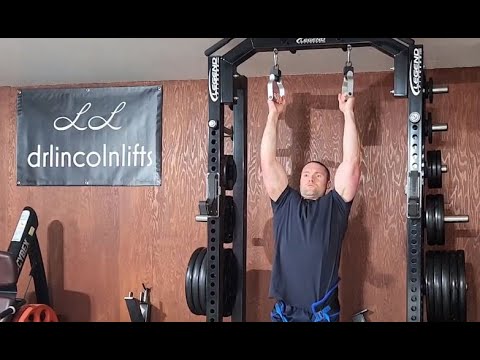
- How to Do it: Hang from a neutral-grip pull-up bar or freely moving handles with palms facing each other. Pull your chest toward the bar by driving your shoulders back and flexing your elbows. Lower with control.
- Sets and Reps: 2 x 6-8
- Rest time: Rest three minutes between sets.
Incline Dumbbell Curls
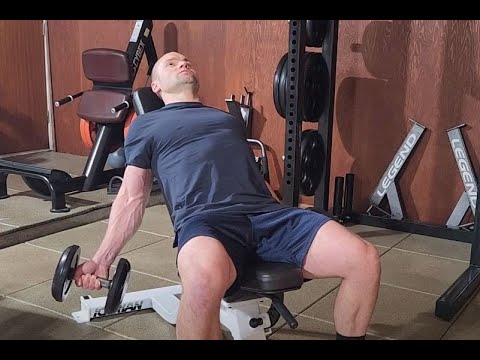
- How to Do it: Perform incline dumbbell curls on a bench set at an approximately 45-degree angle. With underhanded grips on the dumbbells, allow your arms to hang vertically beneath your shoulders. Without swinging your upper arms forward, curl the dumbbells.
- Sets and Reps: 3 x 12-16
- Rest time: Move immediately to the next exercise without rest.
Incline Skull Crusher
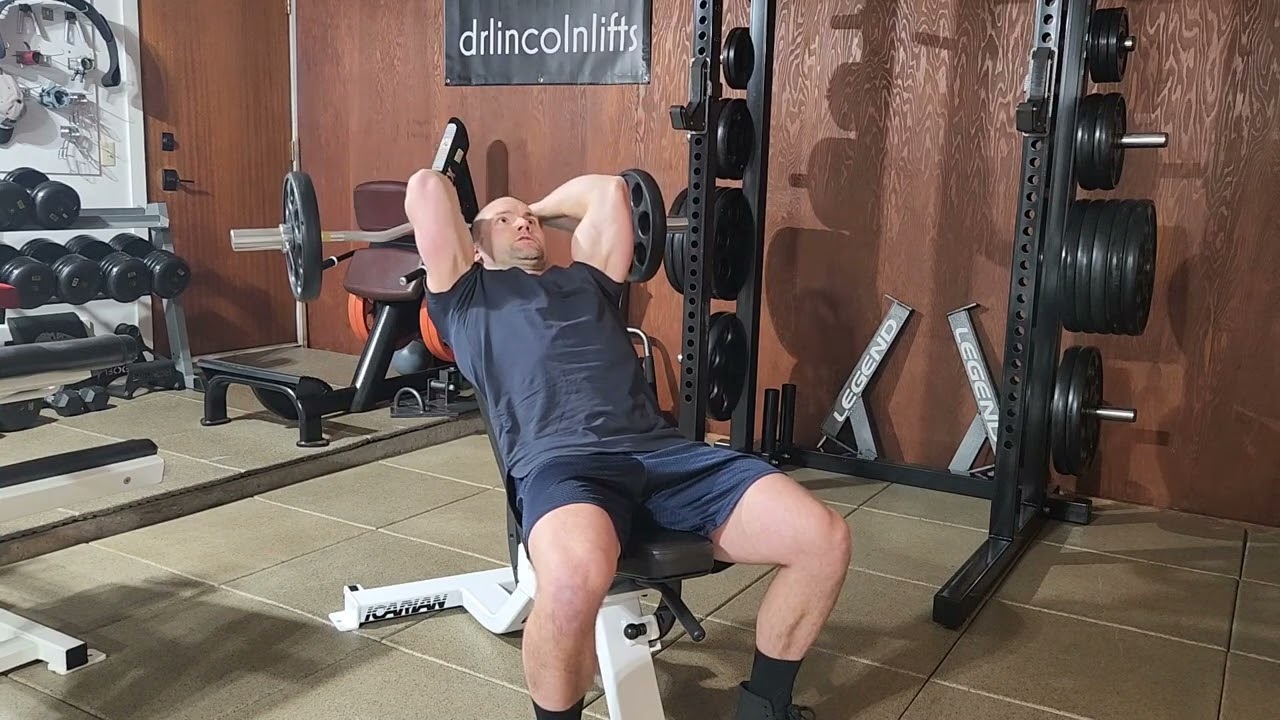
- How to Do it: Take a palms-down grip on the inner handles of an EZ-bar and lie on a 45-degree incline bench. Point your elbows toward the ceiling and allow the bar to lower just behind your head without moving your upper arms. Feel your triceps stretch and then straighten your arms to return to the start position.
- Sets and Reps: 3 x 16-20
- Rest time: Rest two minutes before repeating the previous exercise.
Reverse Biceps Curl
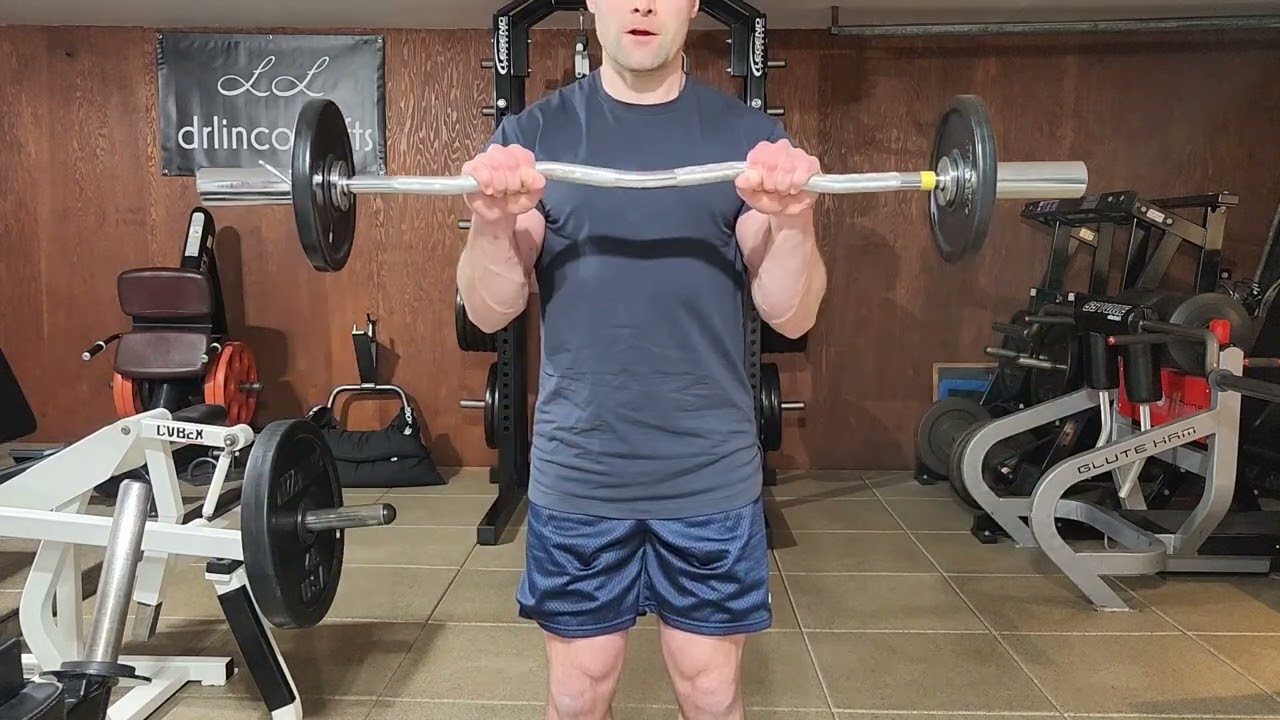
- How to Do it: Perform the standing reverse biceps curl with an overhand grip on an EZ-bar or straight bar. Keeping your arms at your sides, curl the weight by bringing your knuckles toward your shoulders. Return to the start position.
- Sets and Reps: 3 x 12-16
- Rest time: Move immediately to the next exercise without rest.
Gripper
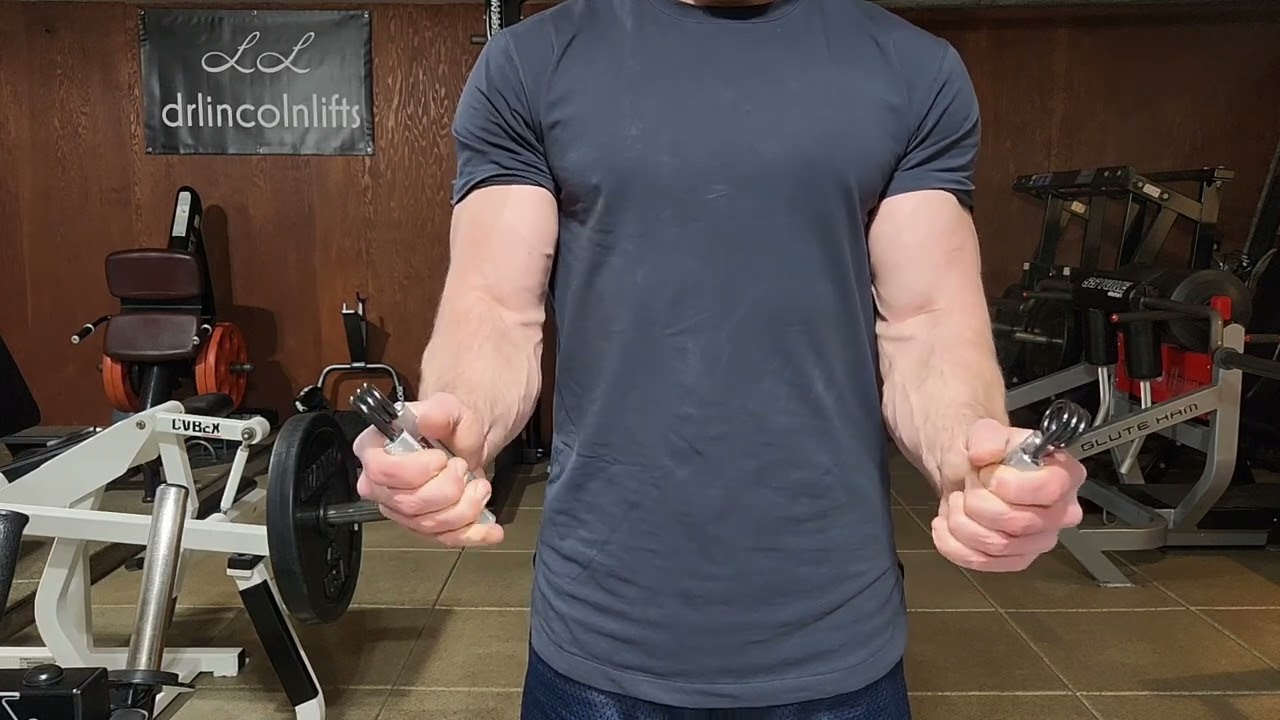
- How to Do it: Hold grip trainers, or the handles of a grip machine, using a power grip with the fingers and thumb of each hand wrapped fully around each handle. Close your hands against the resistance, then slowly control the opening of the grip trainers or machine as far as possible without losing control of the implements.
- Sets and Reps: 3 x 20-24
- Rest time: Rest 90 second before repeating the previous exercise.
Muscles Trained on Arm Day
Arm training has a misconception of being only for vanity and appearance, but well-developed biceps and triceps can contribute to overall strength as well as shoulder and elbow joint health.
Biceps and Elbow Flexors
Your biceps brachii and brachialis add upper arm size, while the brachioradialis adds dimension to the forearm. All three of these muscles are trained via elbow flexion (bending your arms against resistance), whether in single-joint fashion as in the curl variations, or within compound pulling movements like the neutral-grip pull-up.
Triceps
The three heads of your triceps brachii can be trained via resisted elbow extension (arm straightening). Since the long head of the triceps crosses behind the shoulder, triceps exercises that place the shoulder in flexion (e.g. overhead movements including incline skull crushers) may expose the triceps to more mechanical tension. Ultimately, this can result in enhanced growth. (12)(13)
Forearms
When you train your grip, forearm muscles that flex the fingers contract forcefully. These muscles tend to bend your wrists as well. To counteract wrist flexion, the muscles on the opposite side of the forearm (i.e. wrist extensors along the top of your forearm) contract. The result is a robust forearm-training stimulus.
How to Warm-Up Your Arms
Your arm day warm-up can be straightforward: Simply get your body moving. Special attention is given to the wrists, forearms, and elbows. The exercises should be non-fatiguing.
Arm Warm-Up
- Cardio: Five minutes, low-to-moderate intensity effort
- Push-Up: 2 x 8-12
- Zottman Curl: 2 x 8-12
- Dumbbell Wrist Flexion (Wrist Curl): 1 x 8-12
- Dumbbell Wrist Extension (Reverse Wrist Curl): 1 x 8-12
- Neutral-Grip Pull-Up: 2 x 6–10, work-up sets at light to moderate difficulty (e.g. on an assisted pull-up machine if necessary, using a greater amount of assistance than you’d use for your working sets).
Best Bodybuilding Workout for Legs
Leg day is a longer, often more grueling workout compared to other body parts, and rightfully so. If you’re only going to train lower body once per week, you’d better make it count.
While there is debate regarding whether deadlifts belong with back day or leg day, the hamstring-dominant Romanian deadlift (RDL) is programmed in this leg workout, as this variation reduces the overall load required by reducing leg drive without sacrificing training stimulus to the target muscles. Supersets and compound sets are used extensively during this 24-set workout to save time.
The Ultimate Leg Day
Complete once per week. Select weights that allow you to complete repetitions on the lower end of the repetition range. Each set should reach a high level of effort. If you are accustomed to high-volume leg training (e.g. 25+ sets), you may consider adding a set or two to front squats, the squat machine exercise, or leg extensions, as the quadriceps have been shown to respond favorably to higher training volume among well-trained lifters. (10) When you’re able to complete all sets at the top end of the repetition range, add 10 to 20 pounds.
Front Squat
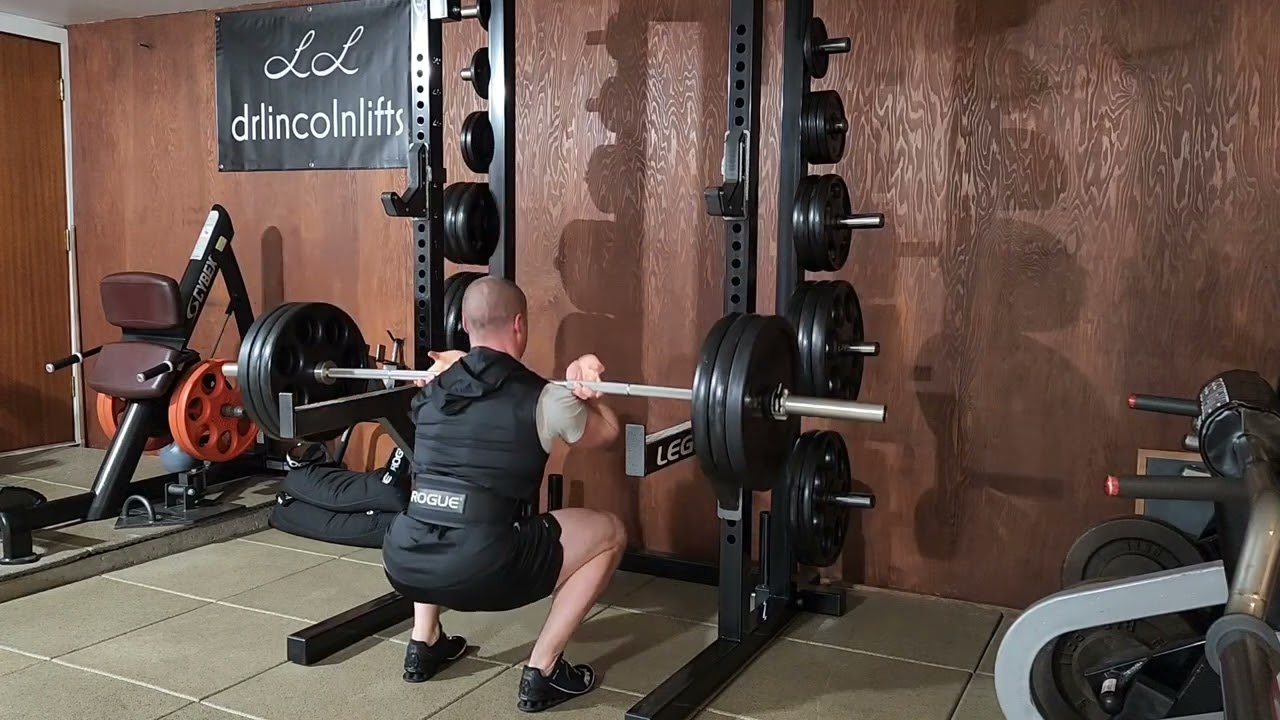
- How to Do it: Support a barbell across the front of your shoulders with a palms-up or cross-arm grip. Keep your trunk as upright as possible as you squat to a comfortable depth.
- Sets and Reps: 3 x 6-8
- Rest time: Move immediately to the next exercise without rest.
Prone Hamstring Curl
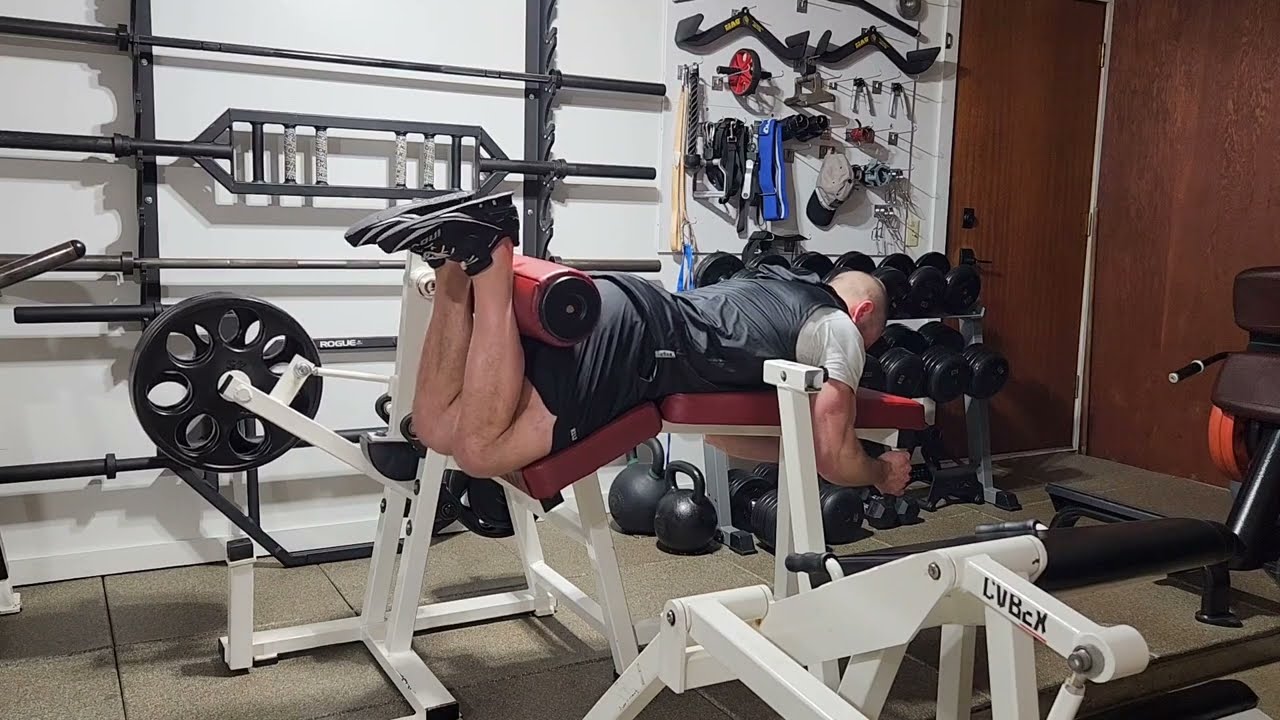
- How to Do it: Lie on a prone hamstring machine with the roller pad contacting just above your heels. Flex your knees through the longest range of motion you can achieve, then control back to the stretched starting position.
- Sets and Reps: 3 x 8-12
- Rest time: Rest three minutes before repeating the previous exercise.
Romanian Deadlift
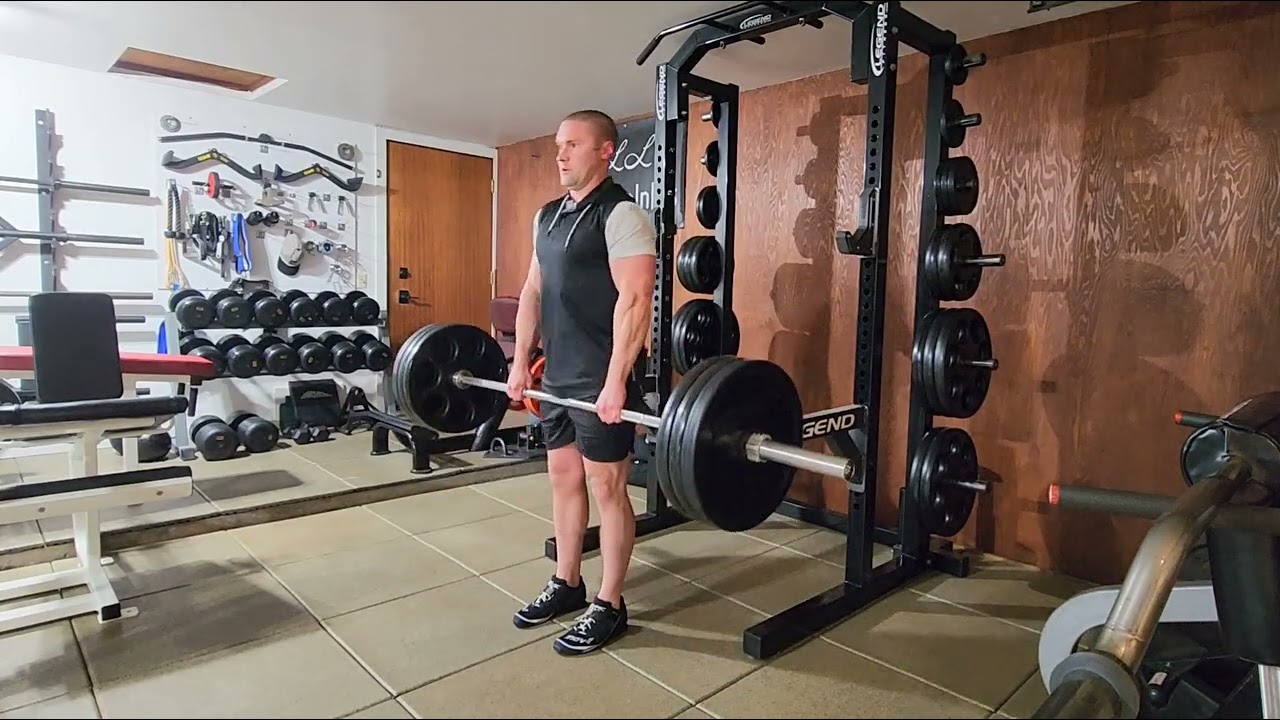
- How to Do it: Hold a barbell in front of your thighs. Begin by lowering from the hips, keeping your knees slightly bent throughout the exercise. Aim to feel a strong stretch in your hamstrings before returning to standing upright.
- Sets and Reps: 3 x 8-12
- Rest time: Move immediately to the next exercise without rest.
Leg Extension
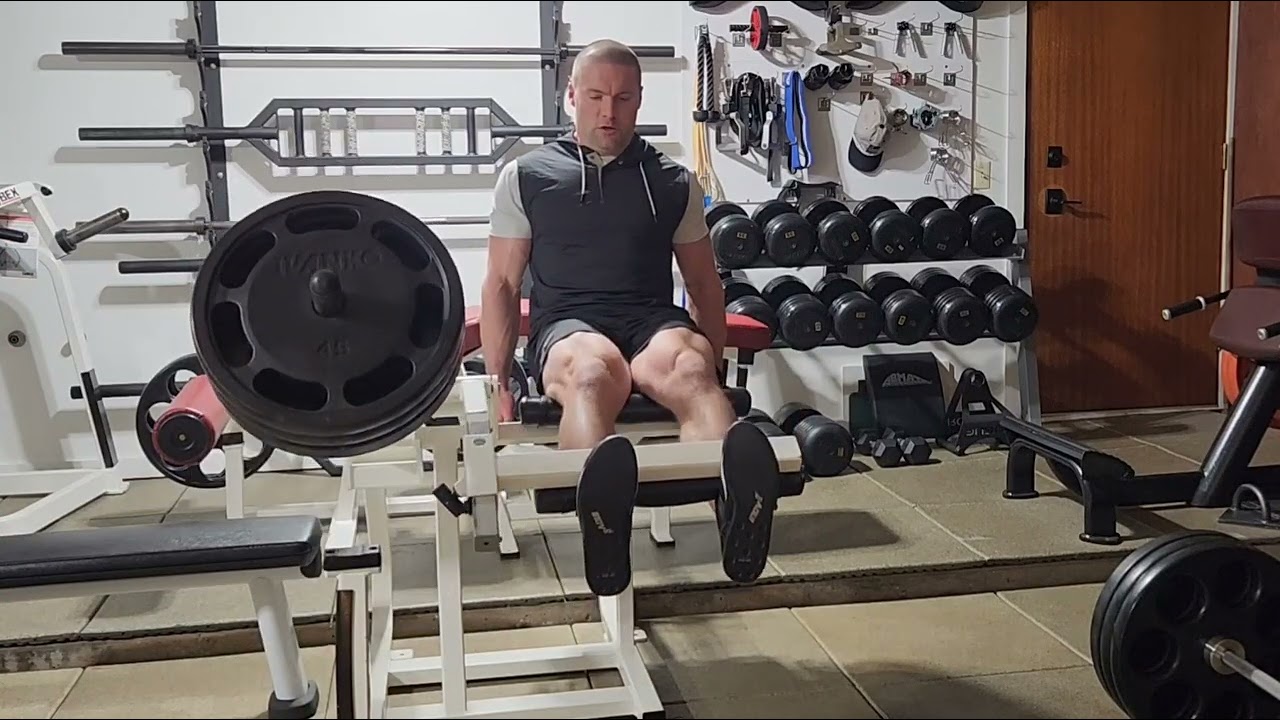
- How to Do it: Sit in a leg extension machine with your knee joint aligned with the pivot point of the moving part of the machine. Straighten your knees, pause very briefly at lockout and then lower slowly with control. Keeping your feet pulled up toward your shins (ankle dorsiflexion) may help you feel a stronger quadriceps contraction.
- Sets and Reps: 3 x 12-16
- Rest time: Rest two and a half minutes before repeating the previous exercise.
Machine Squat
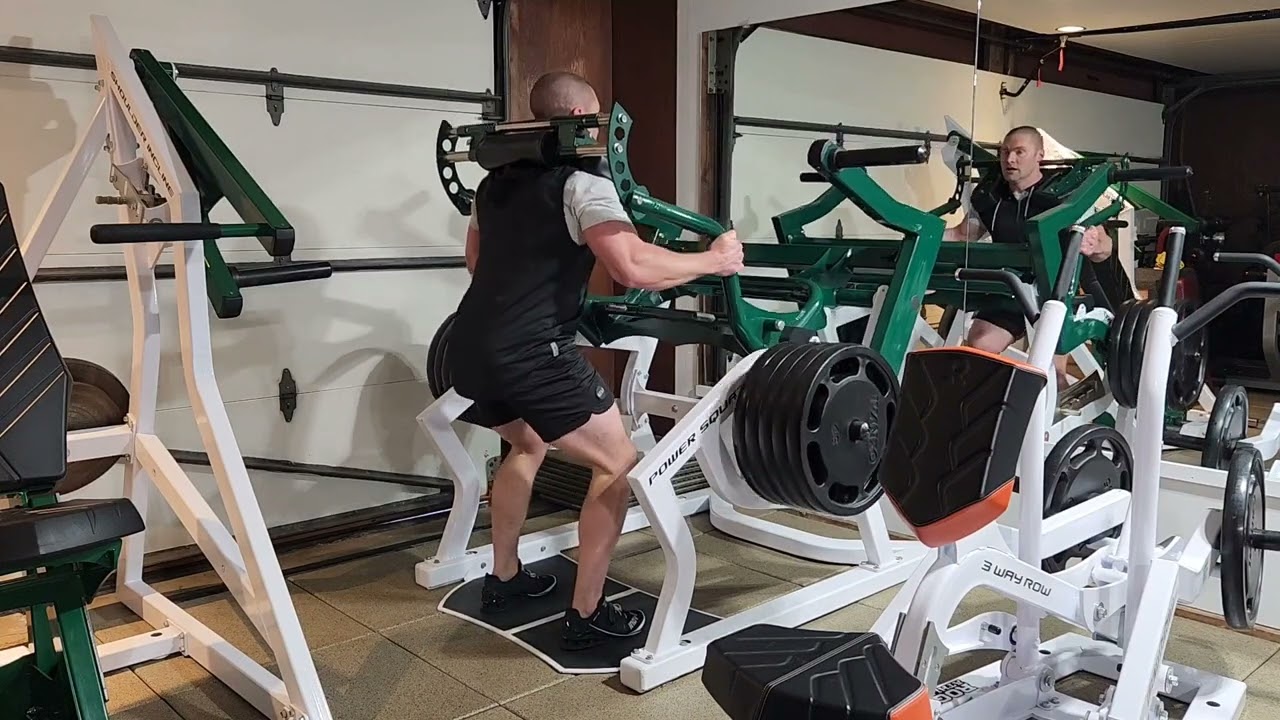
- How to Do it: Pendulum or lever-style squat machines are becoming more popular in gyms; however, if your gym does not have one, a hack squat or leg press machine is an acceptable substitute. Set up under the padded “yoke” of the squat machine, keep your feet flat as you lower into a deep squat. Use a controlled motion at your hips, knees, and ankles. Push back to a nearly locked out position.
- Sets and Reps: 3 x 12-16
- Rest time: Move immediately to the next exercise without rest.
Calf Machine
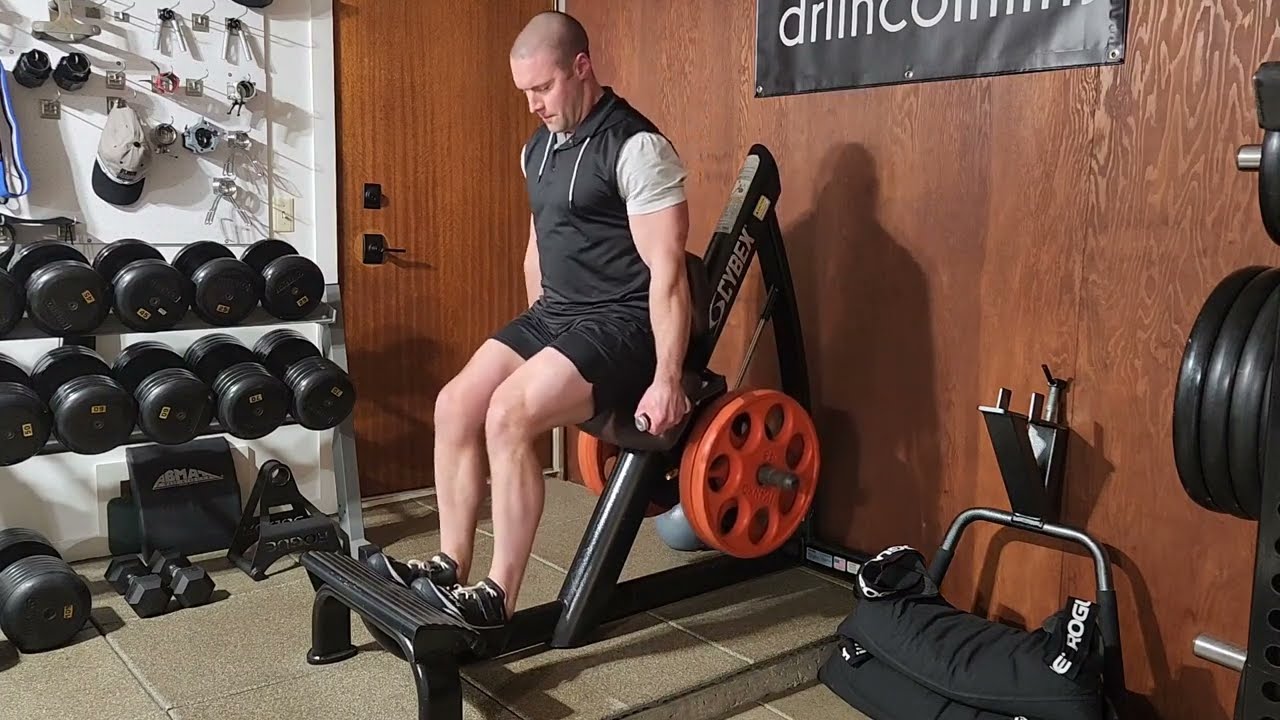
- How to Do it: Locate a calf machine that allows a relatively straight knee position during operation (e.g. standing calf machine or leg press). Lower slowly through your entire ankle range of motion. Without bouncing out of the bottom position, push through the ball of your foot and big toe until you’ve reached the top of your available ankle range of motion. Pause briefly in both the fully stretched and fully contracted positions.
- Sets and Reps: 3 x 16–20
- Rest time: Rest two and a half minutes before repeating the previous exercise.
Back Extension
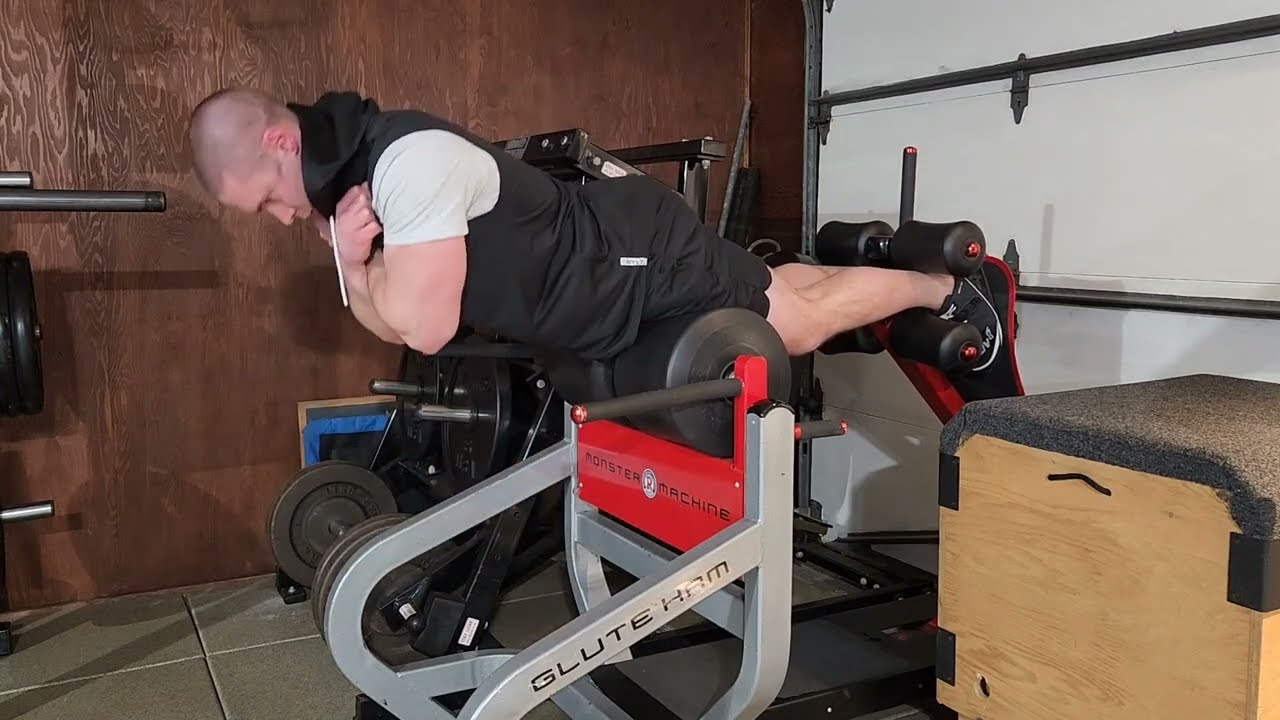
- How to Do it: Hit your lower back, hamstrings, and glutes by setting up in a glute-ham developer (GHD), as shown, or in a 45-degree Roman chair (back extension) with the top of the pad set just below your hip joints. Lower and raise your trunk primarily from the hips; however, it is acceptable to permit some low back movement as well.
- Sets and Reps: 3 x 12-16
- Rest time: Move immediately to the next exercise.
Seated Calf Machine
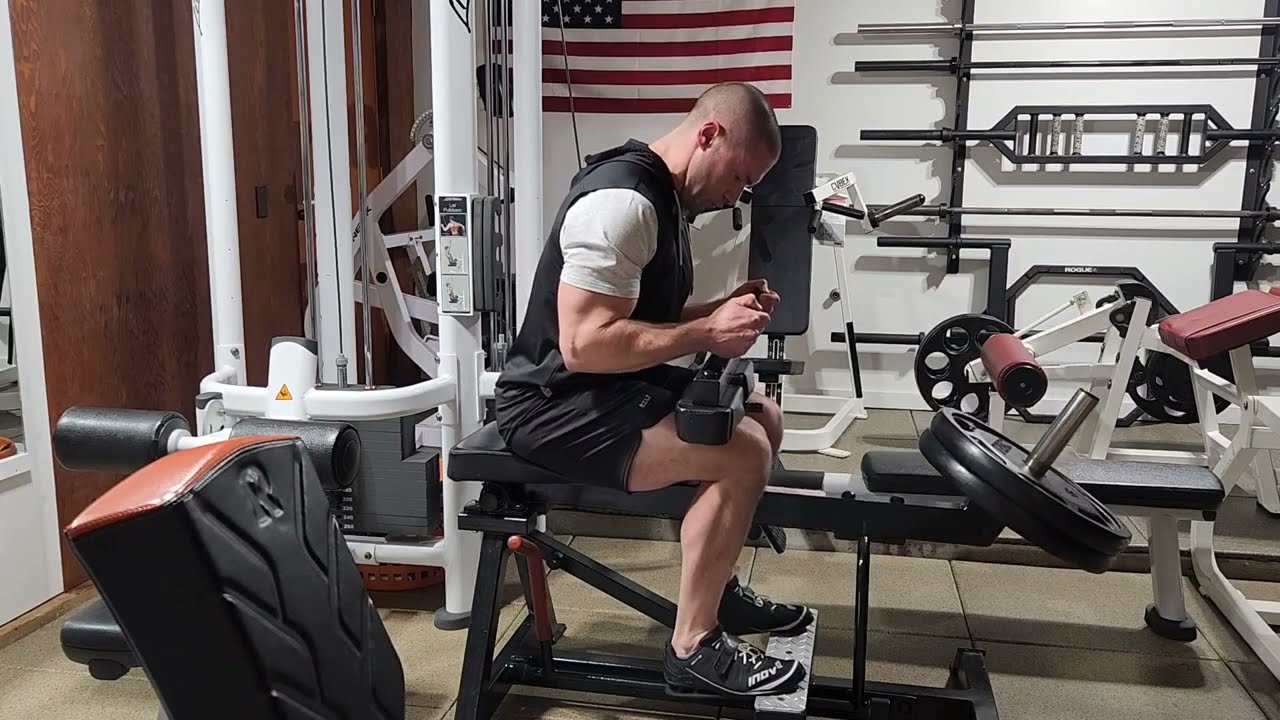
- How to Do it: Set the pads atop your thighs with your knees bent approximately 90-degrees. Lower to the bottom position by allowing your ankles to full dorsiflex. Without bouncing out of the bottom position, raise to the top position of full plantar flexion (rising onto the ball of your foot).
- Sets and Reps: 3 x 20-24
- Rest time: Rest 90 seconds before repeating the previous exercise.
Muscles Trained on Leg Day
Working entire lower body, leg day involves a significant number of separate body parts working in unison for many movements. Targeted isolation exercises will emphasize your quadriceps, hamstrings, or calves for further muscle-building stimulus.
Quadriceps
The quadriceps femoris, or “quads,” refers to the four muscles on the front of your thigh. All four act to extend your knee, and the centermost quadriceps muscle also contributes to hip flexion. You can train these muscles with squats, squat-type movements, and isolated knee extension exercises. For safety and confidence, machine-based exercises may be helpful, especially toward the end of the workout as fatigue sets in.
Glutes
Few muscle groups enhance the image of athleticism like the glutes. Therefore, the glutes are a common target for physique-based training. Although the glutes have various actions at the hip, all three “glutes” — gluteus maximus, gluteus medius, and gluteus minimus — act to extend your hips.
Hamstrings
While your quadriceps are prominent when the legs are viewed from the front, well-developed hamstrings steal the show when the legs are viewed from the side. Composed of four muscles, the hamstrings act to flex the knee, and three of them act to extend the hip. Leg curls train the hamstrings as knee flexors, while the Romanian deadlift and back extension are the primary exercises in the workout for training hamstrings as hip extensors.
Calves
Even if you favor baggy cargo shorts as your go-to warm weather attire, your calves are likely to be the most readily visible lower body muscle group. Although they may receive a modest training stimulus during squats and other squat-like movements, direct calf exercises are typically needed to stimulate meaningful growth.
How to Warm-Up Your Legs
Prepare your lower body for this leg workout with a warm-up that mobilizes stiff hips and lengthens tight muscles. Use front squat warm-up sets to hone technique and dial-in a strong squat stance.
Leg Warm-Up
- Cardio: Five minutes, low-to-moderate intensity effort
- Walking Lunge: 2 x 10 per leg
- Hamstring Sweep: 2 x 10 per leg
- Deep Squat plus Trunk Rotations: 2 x 10
- Front Squat: 3 x 6–10, work-up sets at light to moderate weight (e.g. approximately 40%, 60%, and 80% of the weight to be used for the first set of the workout’s first exercise).
On the Road to Ripped
You’ve probably heard of the “Stairway to Heaven” and the “Highway to Hell,” but the roadmap provided here gets you on the Road to Ripped. When all five workouts are performed once per week, total training per major muscle group is consistent with current best practice recommendations for building muscle. (1)(14) Those accustomed to lengthy or convoluted training sessions will find this program to be refreshingly simple. Simple, but not easy.
References
- Schoenfeld, B., et al. (2021). Resistance training recommendations to maximize muscle hypertrophy in an athletic population: Position stand of the IUSCA. International Journal of Strength and Conditioning, 1(1).
- Lacio, M., et al. (2021). Effects of resistance training performed with different loads in untrained and trained male adult individuals on maximal strength and muscle hypertrophy: a systematic review. International Journal of Environmental Research and Public Health, 18(21), 11237.
- Schoenfeld, B. J. (2013). Potential mechanisms for a role of metabolic stress in hypertrophic adaptations to resistance training. Sports Medicine, 43, 179-194.
- Helms, E. R., et al. (2016). Application of the repetitions in reserve-based rating of perceived exertion scale for resistance training. Strength and Conditioning Journal, 38(4), 42-49.
- Refalo, M. C., et al. (2022). Influence of resistance training proximity-to-failure on skeletal muscle hypertrophy: A systematic review with meta-analysis. Sports Medicine, 1-17.
- Lehman, G. J., et al. (2004). Variations in muscle activation levels during traditional latissimus dorsi weight training exercises: An experimental study. Dynamic Medicine, 3, 1-5.
- Wakahara, T., et al. (2012). Association between regional differences in muscle activation in one session of resistance exercise and in muscle hypertrophy after resistance training. European Journal of Applied Physiology, 112, 1569-1576.
- Grgic, J., et al. (2022). Effects of resistance training performed to repetition failure or non-failure on muscular strength and hypertrophy: a systematic review and meta-analysis. Journal of Sport and Health Science, 11(2), 202-211.
- Franke, A. R., et al. (2015). Analysis of anterior, middle and posterior deltoid activation during single and multijoint exercises. J Sports Med Phys Fitness, 55, 714-721.
- Brigatto, F. A., et al. (2022). High resistance-training volume enhances muscle thickness in resistance-trained men. Journal of Strength and Conditioning Research, 36(1), 22-30.
- Youdas, J. W., et al. (2010). Surface electromyographic activation patterns and elbow joint motion during a pull-up, chin-up, or perfect-pullup
 rotational exercise. The Journal of Strength & Conditioning Research, 24(12), 3404-3414.
rotational exercise. The Journal of Strength & Conditioning Research, 24(12), 3404-3414. - Wackerhage, H., et al. (2019). Stimuli and sensors that initiate skeletal muscle hypertrophy following resistance exercise. Journal of Applied Physiology, 126(1):30-43.
- Maeo, S., et al. (2022). Triceps brachii hypertrophy is substantially greater after elbow extension training performed in the overhead versus neutral arm position. European Journal of Sport Science, 1-11.
- Schoenfeld, B. J., et al. (2019). Calculating set-volume for the limb muscles with the performance of multi-joint exercises: implications for resistance training prescription. Sports, 7(7), 177.
Featured Image: Prostock-studio / Shutterstock
The post The Best Bodybuilding Workouts for Each Body Part appeared first on Breaking Muscle.
source https://breakingmuscle.com/bodybuilding-workout/
Comments
Post a Comment